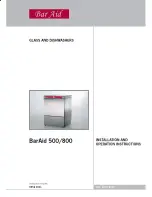
EN
15
PROBLEMS
POSSIBLE CAUSES
SOLUTIONS
The door doesn’t
lock.
Racks are not fit to the end.
Verify that racks are fit to the end.
The door is not lock.
Vigorously push the door until you hear the
“clack”
sound.
The dishwasher
makes excessive
noise.
The dishes are rattling against each.
Arrange the crockery correctly (see
Loading the Racks
).
An excessive amount of foam has been
produced.
The detergent has not been measured out correctly or it is not suitable for
use in dishwashers
(see Filling the Detergent Dispenser)
. Reset the current
cycle by switching OFF the dishwasher, then switch it on again, select a
new program, press START/PAUSE and close the door. Please do not add
any detergent.
The dishes have not
been dried.
The selected program hasn’t any drying
phase.
Verify on the programs table if the selected program has the drying phase.
The rinse aid has run out or the resolution
is not adequate.
Add the rinse aid or adjust the dosage levels higher
(see Filling the Rinse
Aid Dispenser).
The dishes are made of non-stick or
plastic.
It is normal the presence of drops of water
(see Tips).
The dishes are not
clean.
The crockery has not been arranged
properly.
Arrange the crockery correctly
(see Loading the Racks).
The spray arms cannot rotate freely, being
hindered by the dishes.
Arrange the crockery correctly
(see Loading the Racks).
The wash cycle is too gentle and/or deter-
gent efficiency is low.
Select an appropriate wash cycle
(see Programs Table)
.
An excessive amount of foam has been
produced
(see AFTER-SALES SERVICE).
The detergent has not been measured out correctly or it is not suitable for
use in dishwashers
(see Filling the Detergent Dispenser)
. Reset the current
cycle by switching OFF the dishwasher, then switch it on again, select a
new program, press START/PAUSE and close the door. Please do not add
any detergent.
The cap on the rinse aid compartment has
not been shut correctly.
Make sure the cap of the rinse aid dispenser is closed.
The filter is soiled or clogged.
Clean the filter assembly
(see Care and Maintenance)
.
There is no salt.
Fill the salt reservoir
(see Filling the Salt Reservoir).
The dishes and glas-
ses show calcination
or a whitish film.
The salt level is too low.
Fill the salt reservoir
(see Filling the Salt Reservoir).
The adjustment of the water hardness is
not adequate.
Increase the values
(see Water Hardness Table)
.
The cap of the salt reservoir is not proper-
ly closed.
Check to have properly closed the salt reservoir cap.
The rinse aid is used up or the dosage is
insufficient.
Add the rinse aid or adjust the dosage levels higher.
The dishes and
glasses are blue
streaked or have
a bluish tinge.
The rinse aid dosage is excessive.
Adjust the dosage rates below.
TROUBLESHOOTING
Policy and standard documentation and additional product information can be found by:
• Visiting our website:
docs.bauknecht.eu
• Using QR Code
• Alternatively, contact our After-sales Service (See phone number in the warranty booklet).
When contacting our After-sales Service, please state the codes provided on your product’s
identification plate.
The model information can be retrieved using the QR-Code reported in the energy label.
The label also includes the model identifier that can be used to consult the portal of the registry
at https://eprel.ec.europa.eu (available only on certain models).
IEC 436
:
















































